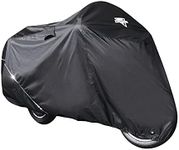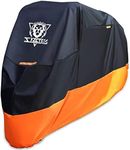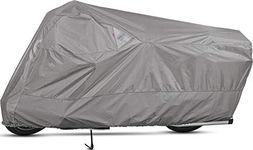Buying Guide for the Best Motorcycle Covers
Choosing the right motorcycle cover is important to protect your bike from weather, dust, and other potential damage when it's not in use. The right cover can help keep your motorcycle looking new, prevent rust, and even deter theft. When shopping for a motorcycle cover, it's important to consider where you'll be storing your bike (indoors or outdoors), the climate in your area, and how often you'll need to put the cover on and take it off. Understanding the key features will help you pick a cover that fits your needs and keeps your motorcycle safe.MaterialThe material of a motorcycle cover determines how well it protects your bike from elements like rain, sun, and dust. Common materials include polyester, nylon, and blends with waterproof coatings. Lightweight materials are easier to handle and store, but may not offer as much protection against harsh weather. Heavier, multi-layered materials provide better protection but can be bulkier. If you store your bike outdoors, look for a durable, weather-resistant material. For indoor storage, a lighter, dustproof cover may be enough.
Water ResistanceWater resistance refers to how well the cover keeps rain and moisture away from your motorcycle. Some covers are water-repellent, meaning they can handle light rain, while others are fully waterproof and can withstand heavy downpours. If you live in a rainy area or plan to store your bike outside, a waterproof cover is essential. For indoor or dry climates, water resistance is less critical, and you can focus on dust protection instead.
Size and FitThe size and fit of the cover are crucial for proper protection. Covers come in different sizes to fit various types of motorcycles, from small scooters to large touring bikes. A cover that's too small won't provide full coverage, while one that's too large can be difficult to secure and may let in dust or water. To choose the right size, check your motorcycle's dimensions and compare them to the cover's specifications. A snug fit is best for outdoor use, while a looser fit may be acceptable for indoor storage.
VentilationVentilation refers to features like built-in vents that allow air to circulate under the cover. This helps prevent moisture buildup, which can lead to rust or mildew. If you live in a humid area or plan to leave your bike covered for long periods, look for a cover with good ventilation. For short-term or indoor use, ventilation is less important, but still helpful to keep your bike in good condition.
Security FeaturesSome motorcycle covers include security features like lock holes or straps that allow you to secure the cover to your bike and deter theft. These features are especially important if you store your motorcycle in a public or shared area. If security is a concern, look for covers with reinforced grommets or built-in locking systems. For private, indoor storage, security features may be less necessary.
UV ProtectionUV protection means the cover can block harmful sunlight, which can fade paint and damage plastic or rubber parts over time. If your motorcycle will be exposed to the sun, even occasionally, a cover with UV protection is a good idea. For indoor storage or shaded areas, this feature is less critical, but it can still help preserve your bike's appearance.
Ease of Use and StorageEase of use refers to how simple it is to put the cover on and take it off, as well as how compactly it can be stored when not in use. Some covers come with storage bags or are designed to fold up small. If you plan to use the cover frequently or take it with you on trips, look for one that's lightweight and easy to handle. For long-term storage, ease of use may be less important, but it's still nice to have a cover that's not a hassle to manage.













